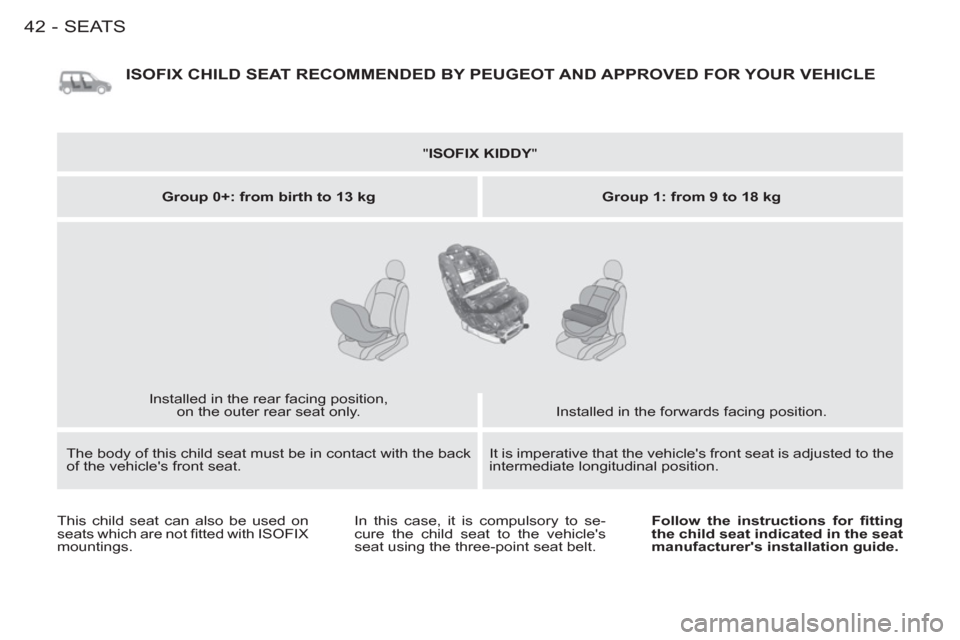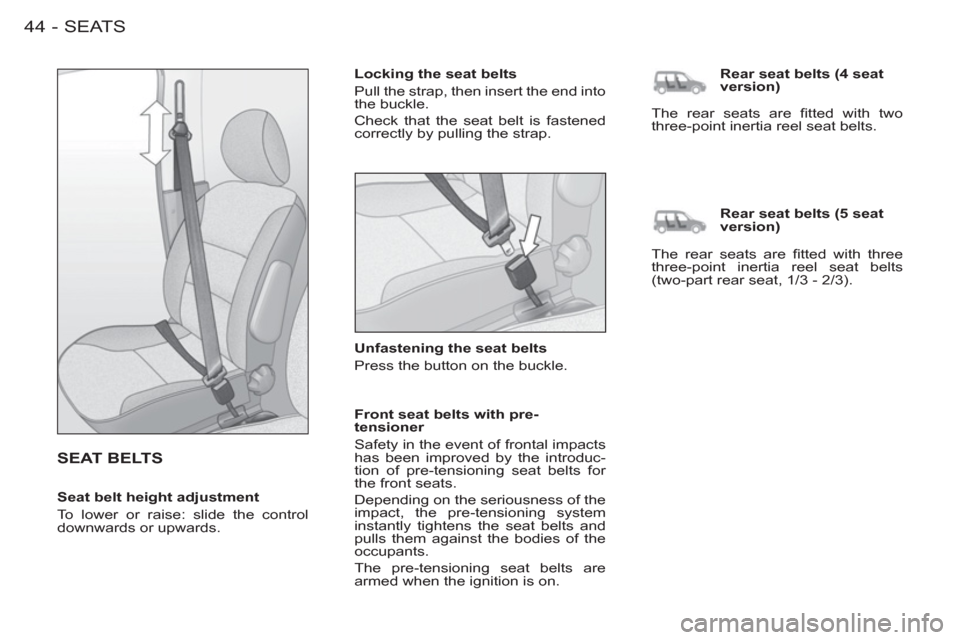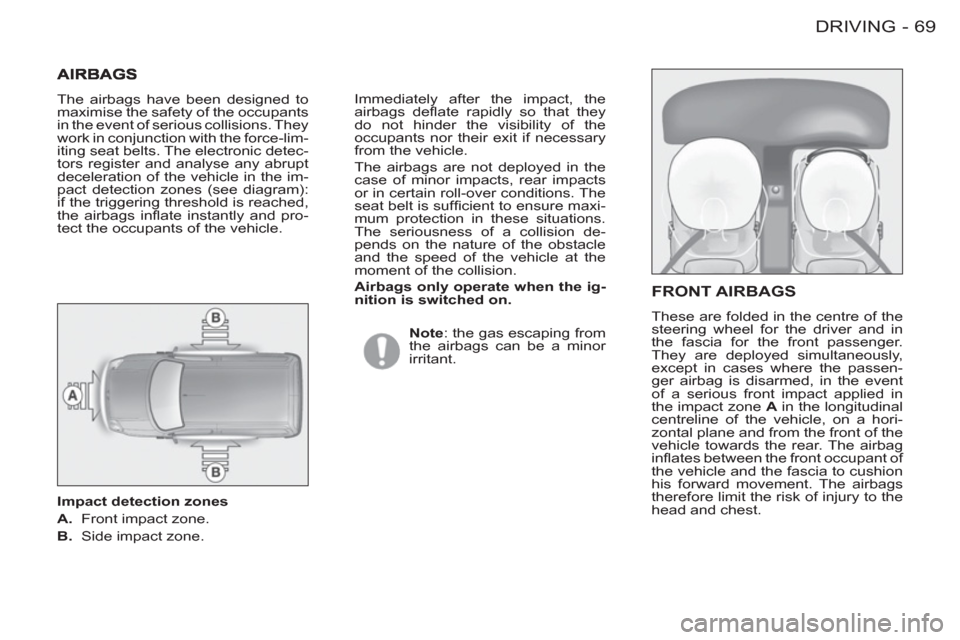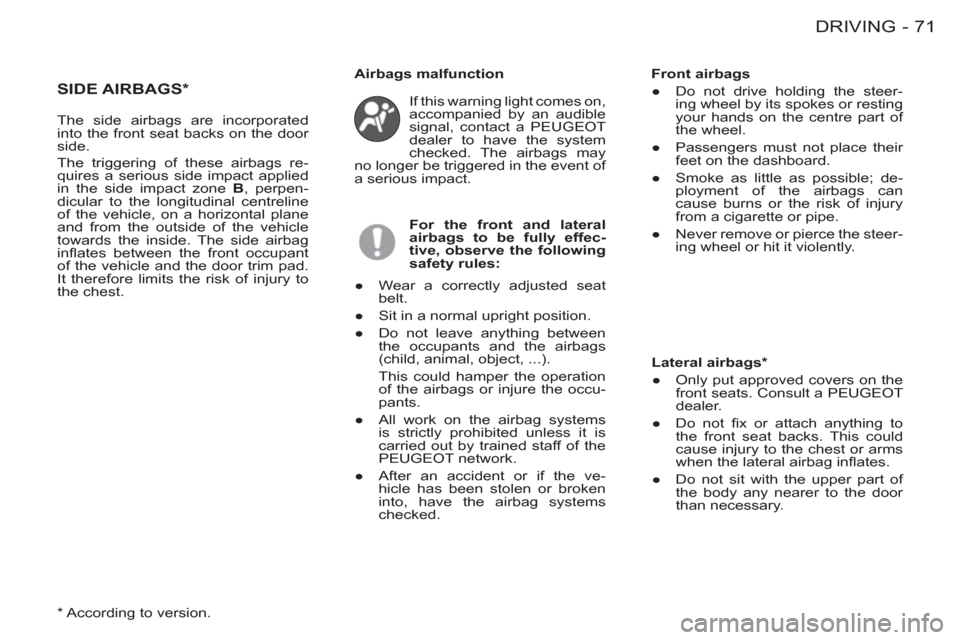2012 Peugeot M59 belt
[x] Cancel search: beltPage 44 of 128

SEATS
42-
ISOFIX CHILD SEAT RECOMMENDED BY PEUGEOT AND APPROVED FOR YOUR VEHICLE
" ISOFIX KIDDY
"
Group 0+: from birth to 13 kg
Group 1: from 9 to 18 kg
Installed in the rear facing position,
on the outer rear seat only. Installed in the forwards facing position.
The body of this child seat must be in contact with the back
of the vehicle's front seat. It is imperative that the vehicle's front seat is adjusted to the
intermediate longitudinal position.
This child seat can also be used on
seats which are not fi tted with ISOFIX
mountings. In this case, it is compulsory to se-
cure the child seat to the vehicle's
seat using the three-point seat belt.
Follow the instructions for fi tting
the child seat indicated in the seat
manufacturer's installation guide.
Page 45 of 128

43SEATS-
ADVICE ON CHILD SEATS Children under the age of 10 must
not travel in the "forward facing" po-
sition on the front passenger seat,
unless the rear seats are already oc-
cupied by other children, cannot be
used or are absent.
Deactivate the passenger's airbag
when a "rear facing" child seat is in-
stalled on the front seat. Otherwise,
the child would risk being seriously
injured or killed if the airbag were to
infl ate. As a safety precaution, do not leave:
- one or more children alone and
unsupervised in a vehicle,
- a child or an animal in a vehicle
which is exposed to the sun, with
the windows closed,
- the keys within reach of children
inside the vehicle.
Installing a booster seat
The chest part of the seat belt must
be positioned on the child's shoulder
without touching the neck.
Ensure that the lap part of the seat
belt passes correctly over the child's
thighs.
PEUGEOT recommends the use of
a booster seat which has a back, fi tted
with a seat belt guide at shoulder
level. To prevent accidental open-
ing of the doors, use the
"Child lock".
Take care not to open the rear win-
dows by more than one third.
To protect young children from the
rays of the sun, fi t side blinds on the
rear windows.
The incorrect installation of a child
seat in a vehicle compromises the
child's protection in the event of an
accident.
Remember to fasten the seat belts
or the child seat harnesses keep-
ing the slack
in relation to the child's
body to a minimum
, even for short
journeys.
For optimum installation of the "for-
ward facing" child seat, ensure that
the back of the child seat is in contact
with the back of the vehicle's seat
and that the head restraint does not
cause any discomfort.
If the head restraint has to be removed,
ensure that it is stored or attached se-
curely to prevent it from being thrown
around the vehicle in the event of
sharp braking.
Page 46 of 128

SEATS
44-
SEAT BELTS
Locking the seat belts
Pull the strap, then insert the end into
the buckle.
Check that the seat belt is fastened
correctly by pulling the strap.
Unfastening the seat belts
Press the button on the buckle.
Front seat belts with pre-
tensioner
Safety in the event of frontal impacts
has been improved by the introduc-
tion of pre-tensioning seat belts for
the front seats.
Depending on the seriousness of the
impact, the pre-tensioning system
instantly tightens the seat belts and
pulls them against the bodies of the
occupants.
The pre-tensioning seat belts are
armed when the ignition is on.
Seat belt height adjustment
To lower or raise: slide the control
downwards or upwards.
Rear seat belts (4 seat
version)
The rear seats are fi tted with two
three-point inertia reel seat belts.
Rear seat belts (5 seat
version)
The rear seats are fi tted with three
three-point inertia reel seat belts
(two-part rear seat, 1/3 - 2/3).
Page 47 of 128

45SEATS-
The driver must ensure that
the passengers use the seat
belts correctly and that they
are all properly restrained
before setting off.
Wherever you are seated in the ve-
hicle, always fasten your seat belt,
even for short journeys.
Do not invert the seat belt buckles as
they will not fulfi l their role fully.
If the seats have armrests * , the lap
part of the seat belt must always
pass under the armrest.
The seat belts are fi tted with an inertia
reel permitting automatic adjustment
of the length of the strap to your size.
The seat belt is stored automatically
when not in use.
Before and after use, ensure that the
seat belt is reeled in correctly.
The lower part of the strap must be
positioned as low as possible on the
pelvis.
The upper part must be positioned in
the hollow of the shoulder.
The inertia reels are fi tted with an auto-
matic locking device which comes into
operation in the event of a collision, on
emergency braking or if the vehicle
rolls over. You can release the device
by pulling rapidly on the strap and re-
leasing it.
In order to be effective, a seat belt:
- must be tightened as close to the
body as possible,
- must restrain one adult only,
- must not bear any trace of cuts or
fraying,
- must be pulled in front of you with
a smooth movement, checking
that it does not twist,
- must not be transformed or modifi ed
to avoid altering its performance.
In accordance with current safety
regulations, all repairs and checks
must be carried out by a PEUGEOT
dealer who guarantees that the work
is carried out correctly.
Have your seat belts checked regu-
larly by a PEUGEOT dealer and par-
ticularly if the straps show signs of
damage.
Clean the seat belt straps with soapy
water or a textile cleaning product,
sold by PEUGEOT dealers.
*
According to model.
Recommendations for children:
- use a suitable child seat if the pas-
senger is less than 12 years old or
shorter than one metre fi fty,
- do not use the strap-guide * when
a child seat is installed,
- never use the same seat belt to
secure more than one person,
- never allow a child to travel on
your lap.
Depending on the nature and se-
riousness of the impacts
, the pre-
tensioning device may be triggered
before and independently of the
airbags. Triggering of the pre-tensioners
is accompanied by a slight emission of
harmless smoke and a noise, due to
the activation of the pyrotechnic car-
tridge incorporated in the system.
In all cases, the airbag warning lamp
comes on.
Following an impact, have the seat
belts system checked, and if neces-
sary replaced, by a PEUGEOT dealer.
After folding or moving a
seat or rear bench seat,
ensure that the seat belt
is positioned and rolled up
correctly.
Page 71 of 128

69 DRIVING
-
FRONT AIRBAGS
These are folded in the centre of the
steering wheel for the driver and in
the fascia for the front passenger.
They are deployed simultaneously,
except in cases where the passen-
ger airbag is disarmed, in the event
of a serious front impact applied in
the impact zone A
in the longitudinal
centreline of the vehicle, on a hori-
zontal plane and from the front of the
vehicle towards the rear. The airbag
infl ates between the front occupant of
the vehicle and the fascia to cushion
his forward movement. The airbags
therefore limit the risk of injury to the
head and chest.
The airbags have been designed to
maximise the safety of the occupants
in the event of serious collisions. They
work in conjunction with the force-lim-
iting seat belts. The electronic detec-
tors register and analyse any abrupt
deceleration of the vehicle in the im-
pact detection zones (see diagram):
if the triggering threshold is reached,
the airbags infl ate instantly and pro-
tect the occupants of the vehicle.
Impact detection zones
A.
Front impact zone.
B.
Side impact zone. Immediately after the impact, the
airbags defl ate rapidly so that they
do not hinder the visibility of the
occupants nor their exit if necessary
from the vehicle.
The airbags are not deployed in the
case of minor impacts, rear impacts
or in certain roll-over conditions. The
seat belt is suffi cient to ensure maxi-
mum protection in these situations.
The seriousness of a collision de-
pends on the nature of the obstacle
and the speed of the vehicle at the
moment of the collision.
Airbags only operate when the ig-
nition is switched on.
Note
: the gas escaping from
the airbags can be a minor
irritant.
Page 73 of 128

71 DRIVING
-
SIDE AIRBAGS *
If this warning light comes on,
accompanied by an audible
signal, contact a PEUGEOT
dealer to have the system
checked. The airbags may
no longer be triggered in the event of
a serious impact.
Airbags malfunction
For the front and lateral
airbags to be fully effec-
tive, observe the following
safety rules:
●
Wear a correctly adjusted seat
belt.
●
Sit in a normal upright position.
●
Do not leave anything between
the occupants and the airbags
(child, animal, object, ...).
This could hamper the operation
of the airbags or injure the occu-
pants.
●
All work on the airbag systems
is strictly prohibited unless it is
carried out by trained staff of the
PEUGEOT network.
●
After an accident or if the ve-
hicle has been stolen or broken
into, have the airbag systems
checked.
Front airbags
●
Do not drive holding the steer-
ing wheel by its spokes or resting
your hands on the centre part of
the wheel.
●
Passengers must not place their
feet on the dashboard.
●
Smoke as little as possible; de-
ployment of the airbags can
cause burns or the risk of injury
from a cigarette or pipe.
●
Never remove or pierce the steer-
ing wheel or hit it violently.
Lateral airbags *
●
Only put approved covers on the
front seats. Consult a PEUGEOT
dealer.
●
Do not fi x or attach anything to
the front seat backs. This could
cause injury to the chest or arms
when the lateral airbag infl ates.
●
Do not sit with the upper part of
the body any nearer to the door
than necessary.
The side airbags are incorporated
into the front seat backs on the door
side.
The triggering of these airbags re-
quires a serious side impact applied
in the side impact zone B
, perpen-
dicular to the longitudinal centreline
of the vehicle, on a horizontal plane
and from the outside of the vehicle
towards the inside. The side airbag
infl ates between the front occupant
of the vehicle and the door trim pad.
It therefore limits the risk of injury to
the chest.
*
According to version.
Page 121 of 128

11 9-
INTERIOR
Stowing rings ........................ 15, 61
Child seats .............................37-43 Front seats.............................34-35
Airbags ..................................69-71 Courtesy lamp,
interior lighting .....................58-59
Child lock (door) ......................... 51
Partially opening rear windows ... 56 Rear seats
(4/5 seat versions) .................... 36
Rear fi ttings .....................15, 62-63
- stowing rings,
- storage boxes,
- hooks,
- retaining net,
- storage pocket,
- storage compartments.
Seat belts...............................44-45